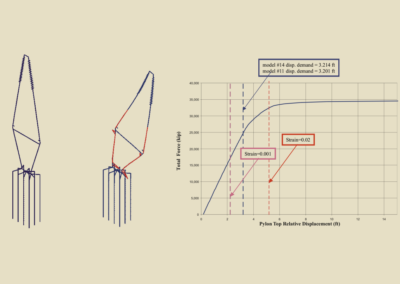Cooper River Bridge Replacement
Seismic evaluation of eight-lane 3,296-foot cable-stayed bridge in South CarolinaPROJECT TYPE
Seismic Evaluation of Cable-Stayed Bridge
LOCATION
Charleston, South Carolina
OWNER
SCDOT
The South Carolina Department of Transportation (SCDOT) embarked on the project involving construction of a new eight-lane cable-stayed main bridge with pedestrian lane and a series of approach and ramp structures. The selected cable-stayed bridge option, the largest cable-stayed span in North America and tallest structure in South Carolina at the time of construction, replaced the Grace and Pearman Bridges and connects the city of Charleston and the Town of Mount Pleasant. It has a main span of 1,546 feet and a cable-supported span length of 3,296 feet. It carries 8 lanes of vehicular traffic and has a 12 foot walkway/bikeway on the south side.
Due to the importance of this bridge, the presence of deep underlying soil deposits, and the history of large earthquakes in Charleston, there are important seismic design considerations for this complex structure. Therefore, SC Solutions performed nonlinear dynamic time-history analyses for three sets of ground motions to assess the seismic performance of the bridge and approach structures. The key components of the 3D nonlinear finite element model are:
- A single integrated model consisting of the main cable-stayed bridge and approach structures, with explicit modeling of the foundations and soil springs.
- Towers and piles were modeled with nonlinear-plastic beam elements using distributed plasticity, considering the confinement and expected concrete and steel properties. Moment-curvature properties were calculated for the entire length of the tower legs.
- Non-linear behavior of the soil and soil-structure interaction were considered using nonlinear plastic and elastic springs along the embedded length of the drilled shaft piers.
Project Awards
Winner of 19 international to local awards, including: the Outstanding Civil Engineering Achievement Award, awarded by ASCE, the 2006 National Grand Award from ACEC, and other awards by AASHTO, AISC, and the Federal Highway Administration.
SC Solutions assessed the bridge using a performance-based design criteria. This involved comparing maximum strains from the three time history analyses to strain limits. Our engineers collaborated closely with the design team to optimize the design, to minimize construction schedule impacts, and to fast track approvals by the peer review panel. This design-build project was completed on time and the new Cooper River bridge – named Arthur Ravenel Jr. Bridge – was opened on July 16, 2005.


